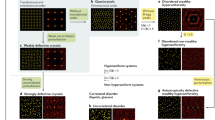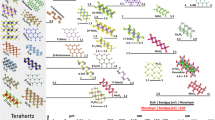Abstract
Understanding and controlling disorder is key to nanotechnology and materials science. Traditionally, disorder is attributed to local fluctuations of inherent material properties such as chemical and structural composition, doping or strain. Here, we present a fundamentally new source of disorder in nanoscale systems that is based entirely on the local changes of the Coulomb interaction due to fluctuations of the external dielectric environment. Using two-dimensional semiconductors as prototypes, we experimentally monitor dielectric disorder by probing the statistics and correlations of the exciton resonances, and theoretically analyse the influence of external screening and phonon scattering. Even moderate fluctuations of the dielectric environment are shown to induce large variations of the bandgap and exciton binding energies up to the 100 meV range, often making it a dominant source of inhomogeneities. As a consequence, dielectric disorder has strong implications for both the optical and transport properties of nanoscale materials and their heterostructures.
This is a preview of subscription content, access via your institution
Access options
Access Nature and 54 other Nature Portfolio journals
Get Nature+, our best-value online-access subscription
$29.99 / 30 days
cancel any time
Subscribe to this journal
Receive 12 print issues and online access
$259.00 per year
only $21.58 per issue
Buy this article
- Purchase on Springer Link
- Instant access to full article PDF
Prices may be subject to local taxes which are calculated during checkout




Similar content being viewed by others
Data availability
All relevant data are available from the authors upon reasonable request.
References
Klingshirn, C. Semiconductor Optics, 3rd edn (Springer, 2007).
Fahey, P. M., Griffin, P. B. & Plummer, J. D. Point defects and dopant diffusion in silicon. Rev. Mod. Phys. 61, 289–384 (1989).
Singh, J. & Bajaj, K. K. Role of interface roughness and alloy disorder in photoluminescence in quantum‐well structures. J. Appl. Phys. 57, 5433–5437 (1985).
Nakamura, S. The roles of structural imperfections in InGaN-based blue light-emitting diodes and laser diodes. Science 281, 956–961 (1998).
Alivisatos, A. P., Harris, A. L., Levinos, N. J., Steigerwald, M. L. & Brus, L. E. Electronic states of semiconductor clusters: homogeneous and inhomogeneous broadening of the optical spectrum. J. Chem. Phys. 89, 4001 (1988).
Tersoff, J. & Legoues, F. K. Competing relaxation mechanisms in strained layers. Phys. Rev. Lett. 72, 3570–3573 (1994).
Haug, H. & Koch, S. W. Quantum Theory of the Optical and Electronic Properties of Semiconductors, 5th edn (World Scientific, 2009).
Rytova, N. S. Screened potential of a point charge in a thin film. Proc. MSU Phys. Astron. 3, 30 (1967).
Keldysh, L. V. Coulomb interaction in thin semiconductor and semimetal films. JETP Lett. 29, 658–661 (1979).
Stier, A. V., Wilson, N. P., Clark, G., Xu, X. & Crooker, S. A. Probing the influence of dielectric environment on excitons in monolayer WSe2: insight from high magnetic fields. Nano Lett. 16, 7054–7060 (2016).
Rösner, M. et al. Two-dimensional heterojunctions from nonlocal manipulations of the interactions. Nano Lett. 16, 2322–2327 (2016).
Raja, A. et al. Coulomb engineering of the bandgap and excitons in two-dimensional materials. Nat. Commun. 8, 15251 (2017).
Cho, Y. & Berkelbach, T. C. Environmentally sensitive theory of electronic and optical transitions in atomically thin semiconductors. Phys. Rev. B 97, 041409 (2018).
Winther, K. T. & Thygesen, K. S. Band structure engineering in van der Waals heterostructures via dielectric screening: the GW method. 2D Mater. 4, 025059 (2017).
Utama, M. I. B. et al. A dielectric-defined lateral heterojunction in a monolayer semiconductor. Nat. Electron. 2, 60–65 (2019).
Haigh, S. J. et al. Cross-sectional imaging of individual layers and buried interfaces of graphene-based heterostructures and superlattices. Nat. Mater. 11, 764–767 (2012).
Zhou, C., Yang, W. & Zhu, H. Mechanism of charge transfer and its impacts on Fermi-level pinning for gas molecules adsorbed on monolayer WS2. J. Chem. Phys. 142, 214704 (2015).
Berkelbach, T. C. & Reichman, D. R. Optical and excitonic properties of atomically thin transition-metal dichalcogenides. Annu. Rev. Condens. Matter Phys. 9, 379–396 (2018).
Wang, G. et al. Colloquium: excitons in atomically thin transition metal dichalcogenides. Rev. Mod. Phys. 90, 021001 (2018).
Li, Y. & Heinz, T. F. Two-dimensional models for the optical response of thin films. 2D Mater. 5, 025021 (2018).
Berghäuser, G. & Malic, E. Analytical approach to excitonic properties of MoS2. Phys. Rev. B 89, 125309 (2014).
Berkelbach, T. C., Hybertsen, M. S. & Reichman, D. R. Bright and dark singlet excitons via linear and two-photon spectroscopy in monolayer transition-metal dichalcogenides. Phys. Rev. B 92, 085413 (2015).
Hill, H. M. et al. Observation of excitonic Rydberg states in monolayer MoS2 and WS2 by photoluminescence excitation spectroscopy. Nano Lett. 15, 2992 (2015).
Brem, S. et al. Intrinsic lifetime of higher excitonic states in tungsten diselenide monolayers. Nanoscale 11, 12381–12387 (2019).
Selig, M. et al. Excitonic linewidth and coherence lifetime in monolayer transition metal dichalcogenides. Nat. Commun. 7, 13279 (2016).
Kazimierczuk, T., Fröhlich, D., Scheel, S., Stolz, H. & Bayer, M. Giant Rydberg excitons in the copper oxide Cu2O. Nature 514, 343–347 (2014).
He, K. et al. Tightly bound excitons in monolayer WSe2. Phys. Rev. Lett. 113, 026803 (2014).
Chernikov, A. et al. Exciton binding energy and nonhydrogenic Rydberg series in monolayer WS2. Phys. Rev. Lett. 113, 076802 (2014).
Conley, H. J. et al. Bandgap engineering of strained monolayer and bilayer MoS2. Nano Lett. 13, 3626–3630 (2013).
Wang, Y. et al. Strain-induced direct–indirect bandgap transition and phonon modulation in monolayer WS2. Nano Res. 8, 2562–2572 (2015).
Roldán, R., Castellanos-Gomez, A., Cappelluti, E. & Guinea, F. Strain engineering in semiconducting two-dimensional crystals. J. Phys. Condens. Matter 27, 313201 (2015).
Lloyd, D. et al. Band gap engineering with ultralarge biaxial strains in suspended monolayer MoS2. Nano Lett. 16, 5836–5841 (2016).
Shin, B. G. et al. Indirect bandgap puddles in monolayer MoS2 by substrate-induced local strain. Adv. Mater. 28, 9378–9384 (2016).
Aslan, O. B., Deng, M. & Heinz, T. F. Strain tuning of excitons in monolayer WSe2. Phys. Rev. B 98, 115308 (2018).
Niehues, I. et al. Strain control of exciton–phonon coupling in atomically thin semiconductors. Nano Lett. 18, 1751–1757 (2018).
Aslan, O. B. et al. Probing the optical properties and strain-tuning of ultrathin Mo1 − xWxTe2. Nano Lett. 18, 2485–2491 (2018).
Mak, K. F. et al. Tightly bound trions in monolayer MoS2. Nat. Mater. 12, 207–211 (2013).
Ross, J. S. et al. Electrical control of neutral and charged excitons in a monolayer semiconductor. Nat. Commun. 4, 1474 (2013).
Chernikov, A. et al. Electrical tuning of exciton binding energies in monolayer WS2. Phys. Rev. Lett. 115, 126802 (2015).
Borsenberger, P. M. & Bässler, H. The role of polar additives on charge transport in molecularly doped polymers. Phys. Status Solidi B 170, 291–302 (1992).
Cui, X. et al. Multi-terminal transport measurements of MoS2 using a van der Waals heterostructure device platform. Nat. Nanotechnol. 10, 534–540 (2015).
Dean, C. R. et al. Boron nitride substrates for high-quality graphene electronics. Nat. Nanotechnol. 5, 722–726 (2010).
Cadiz, F. et al. Excitonic linewidth approaching the homogeneous limit in MoS2-based van der Waals heterostructures. Phys. Rev. X 7, 021026 (2017).
Ajayi, O. A. et al. Approaching the intrinsic photoluminescence linewidth in transition metal dichalcogenide monolayers. 2D Mater. 4, 031011 (2017).
Courtade, E. et al. Charged excitons in monolayer WSe2: experiment and theory. Phys. Rev. B 96, 085302 (2017).
Manca, M. et al. Enabling valley selective exciton scattering in monolayer WSe2 through upconversion. Nat. Commun. 8, 14927 (2017).
Stier, A. V. et al. Magnetooptics of exciton Rydberg states in a monolayer semiconductor. Phys. Rev. Lett. 120, 057405 (2018).
Katoch, J. et al. Giant spin-splitting and gap renormalization driven by trions in single-layer WS2/h-BN heterostructures. Nat. Phys. 14, 355–359 (2018).
Kulig, M. et al. Exciton diffusion and halo effects in monolayer semiconductors. Phys. Rev. Lett. 120, 207401 (2018).
Cadiz, F. et al. Exciton diffusion in WSe2 monolayers embedded in a van der Waals heterostructure. Appl. Phys. Lett. 112, 152106 (2018).
Acknowledgements
The authors thank M.M. Glazov and D.R. Reichman for interesting and helpful discussions. The authors thank all our colleagues who have contributed to individual sample preparation: G. Arefe, H.M. Hill, J. Hone, P. Nagler, T. Korn, A.F. Rigosi, J. Yu, A. van der Zande and X. Zhang. Financial support by the DFG via Emmy Noether grant no. CH 1672/1-1 and Collaborative Research Center SFB 1277 (B05) is acknowledged. This research was supported by the AMOS programme at the SLAC National Accelerator Laboratory within the Chemical Sciences Geosciences and Biosciences Division for data analysis, by the National Science Foundation under grant no. DMR-1708457 for the fabrication of samples on h-BN, and by the Gordon and Betty Moore Foundation’s EPiQS programme through grant no. GBMF4545 for spectroscopic measurements. A.R. acknowledges funding through the Heising-Simons Junior Fellowship within the Kavli Energy NanoScience Institute at the University of California, Berkeley. L.W. acknowledges support by the Alexander von Humboldt Foundation. This work was partially supported by the US–Israel Binational Science Foundation grant no. BSF-2016362 (Y.C. and T.C.B.). The Flatiron Institute is a division of the Simons Foundation. The project has also received funding from the Swedish Research Council (VR) and the European Union’s Horizon 2020 research and innovation programme under grant no. 785219 (Graphene Flagship). Growth of hBN crystals was supported by the Elemental Strategy Initiative conducted by the MEXT, Japan and the CREST (JPMJCR15F3), JST.
Author information
Authors and Affiliations
Contributions
A.C. and A.R. conceived the idea, with L.W., T.C.B and T.F.H. providing additional input. A.R., L.W., J.Z., J.D.Z., M.K. and A.C. prepared the samples, carried out the experiments and analysed the data. Y.C. and T.C.B. performed theoretical calculations of the dielectric effects. S.B. and E.M. performed calculations of the exciton–phonon scattering rates. T.T. and K.W. provided high-quality hBN crystals. A.C., A.R. and L.W. wrote the manuscript with input from all authors.
Corresponding authors
Ethics declarations
Competing interests
The authors declare no competing interests.
Additional information
Publisher’s note: Springer Nature remains neutral with regard to jurisdictional claims in published maps and institutional affiliations.
Supplementary information
Supplementary Information
Supplementary Sections 1–10, Supplementary Figs. S1–S15, Supplementary refs. 1–30.
Rights and permissions
About this article
Cite this article
Raja, A., Waldecker, L., Zipfel, J. et al. Dielectric disorder in two-dimensional materials. Nat. Nanotechnol. 14, 832–837 (2019). https://doi.org/10.1038/s41565-019-0520-0
Received:
Accepted:
Published:
Issue Date:
DOI: https://doi.org/10.1038/s41565-019-0520-0
This article is cited by
-
Monolayer indium selenide: an indirect bandgap material exhibits efficient brightening of dark excitons
npj 2D Materials and Applications (2024)
-
Tailoring the dielectric screening in WS2–graphene heterostructures
npj 2D Materials and Applications (2023)
-
Exciton transport in atomically thin semiconductors
Nature Communications (2023)
-
Localization and interaction of interlayer excitons in MoSe2/WSe2 heterobilayers
Nature Communications (2023)
-
Tip-induced excitonic luminescence nanoscopy of an atomically resolved van der Waals heterostructure
Nature Materials (2023)



